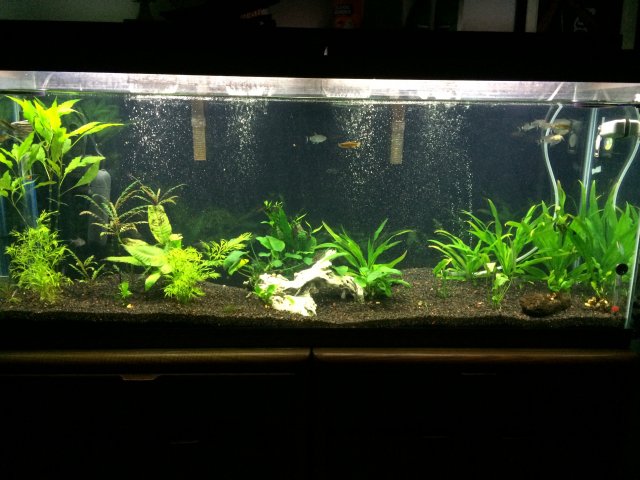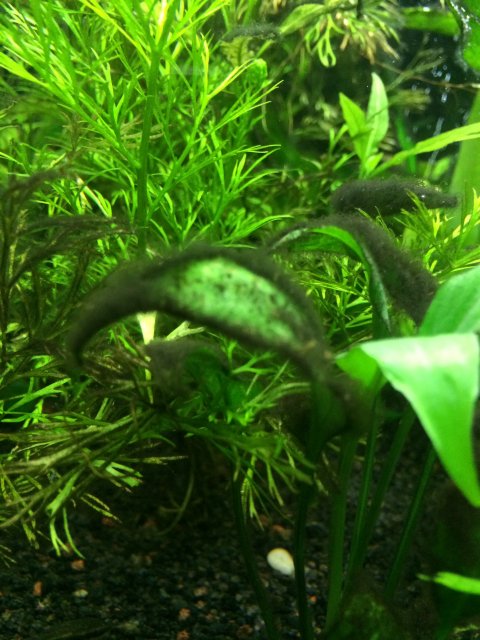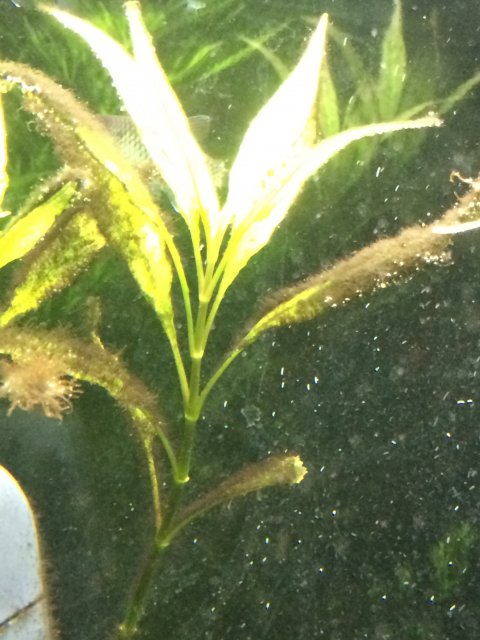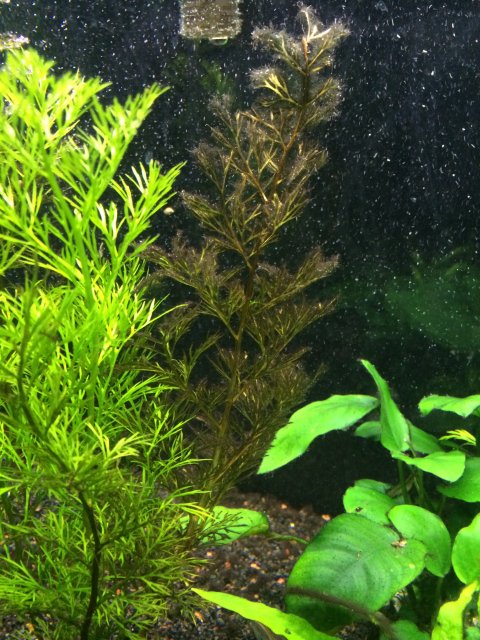What is this?
- Thread starter juancruz05
- Start date
You are using an out of date browser. It may not display this or other websites correctly.
You should upgrade or use an alternative browser.
You should upgrade or use an alternative browser.
at first i thought it might be hair algae but based on pictures from the web, i don't think that's it.
Byron Amazonas
AC Members
Yes, that is our old friend (well, enemy, actually) brush algae. This can be devasting if not controlled. And control is a matter of light and nutrients being balanced for your plant species/numbers. This is the only algae I have ever had to really manage.
If you could give some data on this tank, such as lighting (type, K, watts, duration...), nutrient fertilization (what and how much and how often), and plant species, it would help a lot. A photo of the entire tank will answer the last item as it will let us see what's in there.
Byron.
If you could give some data on this tank, such as lighting (type, K, watts, duration...), nutrient fertilization (what and how much and how often), and plant species, it would help a lot. A photo of the entire tank will answer the last item as it will let us see what's in there.
Byron.
curse you brush algae.
I have (2) T-5 daylight bulbs that were on about 10hrs a day
i dosed dry micor/marco mix twice a week (http://www.aquariumfertilizer.com/index.asp)
So i kept the lights off for a week, trimmed off the leaves that had the algae, did a water change.
i have changed to the plant tabs that go in the substrate so that the algae doesn't get to the nutrients.
i have reduced the amount of light to about 6 hours a day. Any other tips to keep it at bay?


I have (2) T-5 daylight bulbs that were on about 10hrs a day
i dosed dry micor/marco mix twice a week (http://www.aquariumfertilizer.com/index.asp)
So i kept the lights off for a week, trimmed off the leaves that had the algae, did a water change.
i have changed to the plant tabs that go in the substrate so that the algae doesn't get to the nutrients.
i have reduced the amount of light to about 6 hours a day. Any other tips to keep it at bay?


Byron Amazonas
AC Members
curse you brush algae.
I have (2) T-5 daylight bulbs that were on about 10hrs a day
i dosed dry micor/marco mix twice a week (http://www.aquariumfertilizer.com/index.asp)
So i kept the lights off for a week, trimmed off the leaves that had the algae, did a water change.
i have changed to the plant tabs that go in the substrate so that the algae doesn't get to the nutrients.
i have reduced the amount of light to about 6 hours a day. Any other tips to keep it at bay?
View attachment 211783
Yes, one more idea on top of what you are doing: floating plants. Water Sprite (Ceratopteris cornuta) is probably the best, as it is very fast, will grow large (two plants will in not much time completely cover the surface of that tank), provides good shade, and is interesting as a plant. Frogbit is similar. Water Lettuce is another. I would go with these before the tiny plants like Salvinia and Duckweed. Some stem plants do well floating too. Brazilian Pennywort is my favourite for this. Cabomba and Wisteria are two others that should work with your light (they don't for me as I have less intense lighting).
Reducing the photoperiod (duration) is a good move, as you clearly have an imbalance which I will explain. Your T5 lighting I will assume is HO (correct me if this is a mistaken assumption), and that is very bright light. I tried it for a week (two 48-inch tubes over my 5-foot 115g tank) and it was so bright I thought the fish would be asking for sunglasses. [I now have two T8 tubes which works better for me as I have moderate light-requiring plants.] I have not tried the dry fertilizers you linked, since in my situation this would be too much as it would be beyond my light, but from what I have read the dry are a good product. However, one thing missing is carbon. Without CO2 diffusion, the higher light and fertilizers will give algae an advantage, as here. I've been through this too, and I simply reduced my light duration until I found the balance.
This is why I suggest floating plants. Without adding CO2 you are going to have a bit of an imbalance between light and nutrients. But adding the floaters, plus reducing the duration, should help. On the duration I'll just mention that the duration and the intensity are not interchangeable. In other words, if the light is not bright enough, keeping it on longer will not compensate, and vice-versa. Plants need light of a specific intensity (this varies with plant species), balanced by all nutrients being available; only then can they photosynthesize full out. And algae is at a big disadvantage. But as soon as some essential is no longer available, and here it would be CO2 (carbon), photosynthesis will slow and algae has an advantage.
I have been able to eliminate brush algae by reducing the duration of light, and in other cases by lessening the nutrient fertilization. Each aquarium is different biologically, so it can take some experimenting to find that balance.
Increasing CO2 naturally may help too, depending what you are doing maintenance-wise now. CO2 occurs from fish and plant and bacteria respiration, but the majority of CO2 comes from the breakdown of organics primarily in the substrate. Leaving the substrate "dirty," by not cleaning down into it, will keep organics there and provide more CO2. Snails (Malaysian Livebearing, pond, etc) also help as they break down the organic waste faster, allowing the bacteria to get using it quicker.
One comment on substrate vs liquid fertilizers: some nutrients are only taken up primarily via the leaves, so they must be in the water column. You might want to do one liquid dose.
I would leave the light at six hours for the present, and add some floating plants, and perhaps reduce the dry fertilizers. Not knowing their exact composition and quantity in a "dose," I can't say much more on these. Keep a close eye on things. The algae that is there won't go away, but the aim with the changes is to prevent it from increasing, and when that happens, you have found the balance. At that point, you might be able to increase the duration a bit, I would say one hour at a time, leaving it for 3 weeks before any other changes.
Byron.
Siamese Algae Eaters enjoy a buffet of brush algae, BUT it is wise to fix the source of the imbalance which is key to having a long term solution. I fixed my problem with brush algae by adding some SAE to the problem tank and planting some water wisteria and allowing it to run wild. I mean really let it take over! Trim it after a while of you want, but as long as it's growing, it's soaking up extra nutrients that algae is taking advantage of. Like Byron said, every situation is different.
Sent from my iPhone using MonsterAquariaNetwork app
Sent from my iPhone using MonsterAquariaNetwork app
Byron Amazonas
AC Members
It is true that the SAE will eat brush algae, it is one of only two fish that usually do (can't remember the other, but it is very rare). But I don't like suggesting this solution as it carries other significant issues. For one thing, this fish attains six inches so it is not small, and being a shoaling fish by nature, it does best in a group of five or more and a distinct hierarchy will be formed within the group. I think it best to solve the cause, rather than band-aid and open up other issues. You have the space (a 4-foot tank), so if you were to add several chunks of bogwood, a group of SAE would be fine, but also a major impact on the tank's biology.
Byron.
Byron.
I have been battling this crap for a couple of years. The ONLY thing, for me, that has helped….not eradicated, but helped keep it in check…is my photoperiod. Cut it way back, like 5-6 hours. Be very diligent about cleaning it off of things and trimming leaves. You can "paint" directly on the heavy areas with prime which will kill it. Over time you should be able to check it. But mark my words….you have to continue to be very careful. It will come back. Even if you think it's totally gone and drop your guard….POW….
Byron Amazonas
AC Members
Just noticed that I neglected to mention the confusion over the so-called Siamese Algae Eater in my previous post; wasn't quite awake yet I guess. Sorry about that, but here it is.
The common name "Siamese Algae Eater" is regularly applied to several related but distinct species. The species Crossocheilus langei is the one most often encountered in the hobby as the "Siamese Algae Eater" [SAE] and is the best at eating black brush [aka red beard] algae. The "true" SAE is actually Crossocheilus siamensis, a species initially described by H.M. Smith in 1931 as Epalzeorhynchus siamensis and moved by Banarescu into the genus Crossocheilus in 1986, and which has probably never been seen by hobbyists, since the holotype [the specimen collected and used for the description] is the only one known. To further confuse, C. siamensis is now considered a synonym for the actual species name, Crossocheilus oblongus.
Confusion abounds with this fish, beyond the above. There are several near-identical species within Crossocheilus, and they are occasionally seen in the hobby. Their usefulness as "algae eaters" is variable, depending upon the species. Then there are two other fish often confused with the SAE, known as the False Siamese Algae Eater, Garra cambodgiensis, and the Flying Fox, Epalzeorhynchos kalopterus. Both of these regularly appear in the hobby, but neither will handle brush/beard algae like the common SAE. The False SAE can be distinguished by the dark lateral band that ends at the caudal peduncle whereas on the subject fish this band continues into the caudal fin. The Flying Fox has white-edged red and black coloured fins, not clear fins as in the subject species.
Then there is the Chinese Algae Eater, so-called, a fish that is sometimes offered as a SAE. This species is Gyrinocheilus aymonieri and though commonly seen in stores, it is not a very desirable fish at all. While it may eat common algae when immature, it eats less and less as it matures, until it decide to chow down on other fish. It can attain a decent size too, up to 12 inches, though in aquaria it usually attains 6-8 inches. Given its tenacity and size, not a fish for the average home aquarium.
Byron.
The common name "Siamese Algae Eater" is regularly applied to several related but distinct species. The species Crossocheilus langei is the one most often encountered in the hobby as the "Siamese Algae Eater" [SAE] and is the best at eating black brush [aka red beard] algae. The "true" SAE is actually Crossocheilus siamensis, a species initially described by H.M. Smith in 1931 as Epalzeorhynchus siamensis and moved by Banarescu into the genus Crossocheilus in 1986, and which has probably never been seen by hobbyists, since the holotype [the specimen collected and used for the description] is the only one known. To further confuse, C. siamensis is now considered a synonym for the actual species name, Crossocheilus oblongus.
Confusion abounds with this fish, beyond the above. There are several near-identical species within Crossocheilus, and they are occasionally seen in the hobby. Their usefulness as "algae eaters" is variable, depending upon the species. Then there are two other fish often confused with the SAE, known as the False Siamese Algae Eater, Garra cambodgiensis, and the Flying Fox, Epalzeorhynchos kalopterus. Both of these regularly appear in the hobby, but neither will handle brush/beard algae like the common SAE. The False SAE can be distinguished by the dark lateral band that ends at the caudal peduncle whereas on the subject fish this band continues into the caudal fin. The Flying Fox has white-edged red and black coloured fins, not clear fins as in the subject species.
Then there is the Chinese Algae Eater, so-called, a fish that is sometimes offered as a SAE. This species is Gyrinocheilus aymonieri and though commonly seen in stores, it is not a very desirable fish at all. While it may eat common algae when immature, it eats less and less as it matures, until it decide to chow down on other fish. It can attain a decent size too, up to 12 inches, though in aquaria it usually attains 6-8 inches. Given its tenacity and size, not a fish for the average home aquarium.
Byron.
Thanks and i forgot to mention that i do have CO2 setup. 20gal CO2 tank that comes on an hour before the lights come on and goes off when the lights go off. I will keep an eye on this and invest on some Wisteria and Water Sprite





